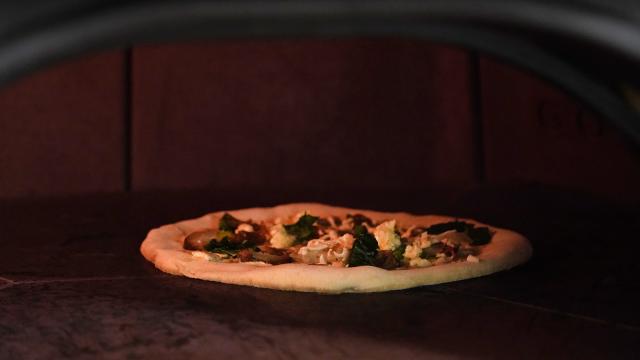Another sign of how fundamentally screwed the economics underlying the app economy are: It is possible to take advantage of exploitative food delivery platform DoorDash’s efforts to sign up restaurants without their consent to engage de facto “pizza arbitrage,” according to a report by the Margins.
Arbitrage is, simply put, purchasing an asset of some kind at one price and simultaneously flipping it a higher price to someone else. In this case, the Margins’ Ranjan Roy wrote, a friend of his who ran a takeout-only pizza restaurant discovered in March 2019 that DoorDash had begun listing his business for delivery without asking first—a strong-arm tactic that the delivery giant uses to push restaurants into setting up partnerships and then start coughing up fees. This created all kinds of problem for the pizzaiolo in question, including customers calling to complain about incorrect delivery orders or ones that showed up cold without the restaurant even being aware DoorDash was advertising delivery from it in the first place.
But DoorDash didn’t stop there. As part of what was apparently a “demand test” to later pitch the restaurant on how many pizzas it could sell through DoorDash, and possibly incorrect automated scraping of the pizzeria’s menu, Doordash delivered the pizzas at cost and with no fees. To be exact, according to the Margins, DoorDash was selling some of the restaurant’s specialty pizzas for its base cheese pizza price of $US16 ($25), a third off the normal price of $US24 ($37). Roy said he realised this enabled pizza arbitrage: In theory, the owner of the pizzeria could order his own pizzas ad infinitum at $US16 ($25) a pop and pocket the $US8 ($12) difference DoorDash paid the restaurant.
This test worked, according to the Margins. The owner placed an order for $US160 ($245) worth of pizza, and DoorDash delivery worker paid the restaurant $US240 ($368) for it on a company card, returning an extra $US80 ($123) to the owner. However, that was reduced to $US10 ($15) after actually accounting for operating expenses, or just $US1 ($2) in arbitrage per pizza. The solution, according to the Margins, was that the owner simply repeated the same process, but while filling the boxes with nothing but dough. That increased the net profit to $US75 ($115), with no actual customer involved to complain. Roy wrote that they repeated this experiment several times to see if DoorDash caught on; it did not. (This process does not appear to account for tips to the drivers, who one would hope were duly compensated for their brief involvement in this mess.)
“Was this a bit shady?” Roy wrote in the post. “Maybe, but fuck DoorDash.”
As the Margins noted, this illustrates a fundamental absurdity of the food delivery business far and beyond just that it’s sort of a shitty market where it’s hard to turn a profit: the biggest players in the field, despite being backed to the tune of billions by investment firms, are all on shaky footing or outright haemorrhaging cash. Grubhub Seamless, which was formerly profitable, lost $US33 ($51) million in the first quarter of 2020.
Its market value had plunged by billions before the coronavirus pandemic, leading to reports it was considering a merger. As of this month, that potential buyer was Uber, whose own Uber Eats business lost $US461 ($706) million in Q4 2019 and may not be profitable until 2024. DoorDash itself lost up to $US450 ($690) million in 2019, and Postmates was reportedly not profitable in 2018.
These losses continue despite these companies combined controlling an estimated 95 per cent of the food delivery market at a time it is growing rapidly. They also continue despite predatory practices like signing up restaurants without their consent, seeing the internet with phone numbers for restaurants that are actually delivery service-operated lines, high fees, and systematic abuse of their armies of poorly-paid delivery contractors. Nobody wins and everyone loses, other than investors and executives making a killing off of sky-high valuations.
One explanation is that each of these companies have more in common with the disastrously imploded MoviePass than they’d like to admit. MoviePass, which built a massive user base by offering unlimited movie ticket subscriptions at cost, eventually burned out like a dumpster fire when it became clear acquiring massive numbers of customers is a bad idea when there’s no path to actually turning a profit on them.
The Margins argued that the only clear path to victory would be to continue this money-burning competition until only one player is left standing, after which the winner could jack up prices—something that a class action lawsuit filed in New York last month claims is already occurring. With just four companies already controlling the market, though, regulators could still stand in the way of further consolidation.
City officials, restaurant lobbying groups, and Democratic members of Congress have all came out against the proposed Grubhub-Uber merger. According to Barron’s, the two companies are at odds over potential terms while analysts on Wall Street are flying red flags about potential antitrust intervention. Separately, some cities are moving to cap commissions collected by delivery services that restaurants say are extortionate.
“We believe consolidation would improve the profit pool for the industry, and complementary strengths in Grubhub’s restaurant supply and Uber’s delivery network are obvious and compelling,” Youssef Squali, an analyst at SunTrust Robinson Humphrey, wrote in a research note, according to Barron’s. “That said, regulators are likely to take a hard look at the deal, as the combined entity would have considerable market share and power in certain localities.”
“We do not believe this potential acquisition of Grubhub by Uber, if true, would easily pass regulatory scrutiny,” BTIG analyst Peter Saleh wrote in a May 12 report, according to Business Insider. “Given the significant market share a combined company would enjoy in the food delivery sector, we believe regulators would think twice.”
